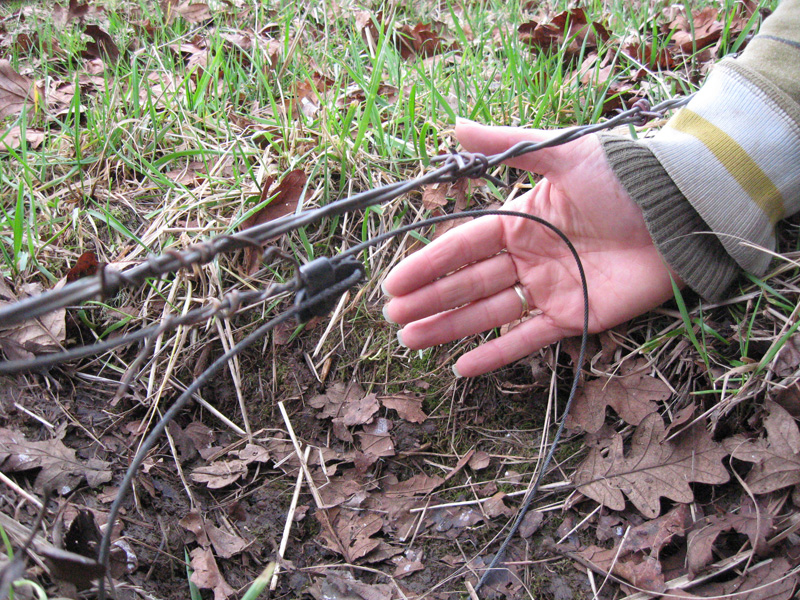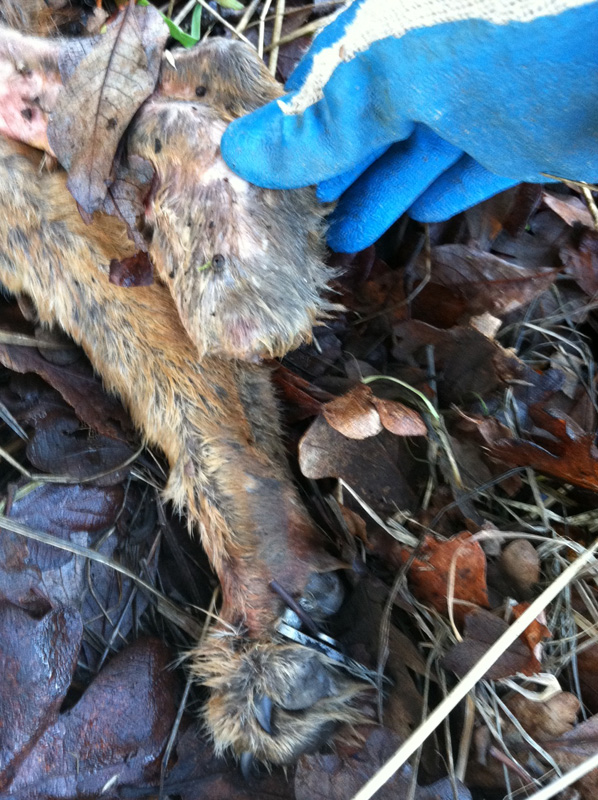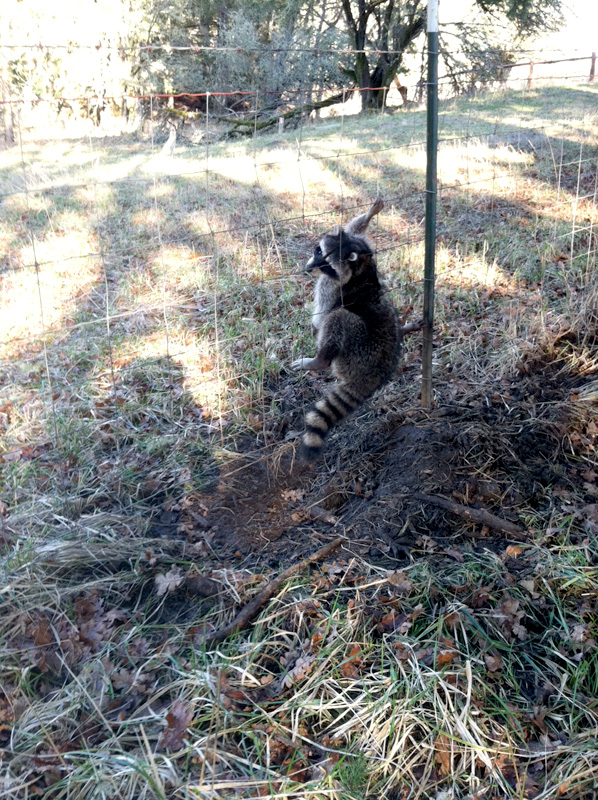ALERT ARCHIVE: OSU snares killing wildlife and endangering neighborhood pets

This snare, and hundreds like it, have
been set at the base of the fence line
around OSU's sheep farm pasture. Their
placement violates both Oregon law and
the directives of USDA Wildlife Services,
the agency who set them.
Call on OSU to end their indiscriminate and inhumane trapping practices and become a leader in humane livestock husbandry
February 22, 2012 - Oregon State University (OSU) currently has a golden opportunity to become a leader in animal husbandry and the humane practice of protecting and raising livestock on their sheep farm.
Along with help from Predator Defense and the local community, one family in Corvallis, OR, who lives next to the OSU sheep farm, makes a clear case for such a change. Read more below and learn how you can help.
- Read the neighbor's report from OSU's sheep farm fence
- Read our letter to OSU President, Edward Ray
- Watch our video, "End Federal Trapping at Oregon State University"
- Take action to immediately suspend wildlife trapping at OSU sheep farm
Eye-Witness Report from the Sheep Farm Fence: One Family's Story
In November 2011 we moved into a house we had spent three years building. It is located on three acres adjacent to the OSU sheep farm pasture.
In June 2011, I stumbled on the body of a dead fawn along the fence line that runs between our property and the sheep pasture. The fawn had been strangled by the neck with a metal cable known as a snare. It was tiny, only weeks old perhaps, and probably got caught in the snare trying to go under the fence to follow its mother who had likely jumped the 4 foot fence. The fawn had been in the trap for considerable time since its body was desiccated, the skin hardened onto the skeleton. The condition of the body told me that animal had been there for many, many days.

Cassandra found this dead coyote with a
snare around its foot. The coyote's other
hind foot
was already missing; it had
chewed it
off
to escape a previous trap.
Just a few months after moving into our new home, our cat went missing. On January 29, 2012, I went looking for the cat in the brush behind the house. From our property I spotted a dead coyote caught in the same fence. It appeared the coyote had become accidentally caught in the fence, and had died, unable to free itself.
Upon further investigation, it became clear that this animal too had been caught in a snare intentionally set along the bottom of the fence line, just as had the snare that had strangled the fawn. In this case the snare was around its foot, and the coyote had completely wrapped itself in and out of the wire fence in a struggle to get free. The other hind foot was missing entirely. I later learned that undoubtedly this coyote had formerly been caught in another trapping device and had chewed its foot off in order to escape.
The following Monday, January 30, I contacted OSU’s sheep farm staff and learned that indeed traps are intentionally set for coyotes through a contract with Wildlife Services, a program under the U.S. Dept. of Agriculture’s Animal and Plant Health Inspection Service. OSU staff explained this is a legal practice and is the only way to keep their sheep safe.
On Thursday, February 2, upon walking the fence line further to take photographs of the fence where more traps were set, I came upon a live raccoon dangling on the fence, caught by the rear leg in the same type of snare trap as the coyote. This raccoon had similarly woven itself through the fence, trying to escape the snare's unyielding grip. I took video and photos of the struggling raccoon that had haplessly gotten caught in a snare set to catch another animal.

Cassandra also found this live raccoon
caught by its rear leg and attempting to
escape by weaving itself through the fence.
Wildlife Services
left it to die.
On February 9, seven days after finding the raccoon, I checked the same trap to determine if Wildlife Services had returned to take care of any unintentionally trapped animals. Based on the trap not appearing to have been touched or reset in that time, there was no indication that the trapper had returned. The raccoon, and any other animal that happened to get stuck in the snare, had been left there to die, hanging on a metal fence like the coyote that I found one week earlier and the fawn I found in June.
The traps were set only 450 ft away from our new home and even closer to a neighbor’s property located approximately 200 ft away. Along with the concern of the indiscriminate taking of innocent wildlife, we are very concerned about the well being of our pets, especially our new dog who is in the process of being trained and has gotten free a few times, and thus could just as innocently have run through one of these snare traps. And, of course what started the awareness of the traps in the first place, was the searching for our cat that would also travel these same paths. A four-foot fence cannot keep out a child, dog or cat, much less a determined predator. A long metal farm gate to this fence has a crawl space underneath it, which is large enough for any animal, including an adult man, to get through. Good fences make good neighbors.
Although our family got a great surprise when our cat returned home after a week away, and we were greatly relieved not to have found her in a snare along that fence line, we decided to ask neighbors and colleagues about the snare traps. We discovered that two family dogs had been caught in trapping devices over the last few years but were lucky enough to have survived. No warning signs regarding traps or snares have been posted for neighbors, nor have any other written or verbal warnings been provided. We learned that although numerous neighbors have in the past contacted OSU requesting that the practice of trapping being stopped, no action was taken by OSU.
Delving further into this issue, I discovered Predator Defense, the national wildlife advocacy organization in Eugene, whose mission is to protect native predators and create alternatives for people to coexist with wildlife. I contacted them for their support and assistance. Thus began my education about the injustices of and real dangers posed by lethal predator control, and about federal and state agencies and regulations governing this practice.
Eighteen days after I found the coyote and began observing the area daily, I found two new warning signs posted and that the traps had been reset. Oregon trapping regulations require that traps set on private property for predatory animal damage control be checked at a minimum of seven-day intervals. That put Wildlife Services in violation of their Directive 2.210, Compliance with Federal, State and Local Laws and Regulations. This directive states that its purpose is to ensure that WS employees are in compliance with federal laws, as well as applicable State and local laws. My observations of no change to the traps during the 18-day interval, and the deteriorated condition of the coyote and the fawn demonstrate that OSU traps are not checked within the seven-day interval required by Oregon law (see Oregon trapping regulations) and that more violations of internal directives had been made by Wildlife Services at the sheep farm.
The following actions demonstrate further violations of Wildlife Services' Directive 2.450, Traps and Trapping Devices:
- Snares and leg hold traps were not set to minimize changes of capturing non-target species.
- Non-target animals were not released alive.
- Target animals were not dispatched immediately, were not removed from capture devices and immediately dispatched and properly disposed of.
- Warning signs were not posted.
- No efforts were taken to notify or obtain approval of adjacent landowners.
- Caution was not taken so that captured animals would not be conspicuous.
For more information on Wildlife Services, visit USDA War on Wildlife.
Prevention, good husbandry and non-lethal means of control should be OSU's first priorities in their efforts to protect livestock. Using these methods will likely preclude the need for lethal control, which should be a last resort, not a first choice.
There are numerous alternative non lethal practices available and used world-wide to keep sheep and lambs safe besides killing wildlife, including the use of “New Zealand fencing,” hot wires around a fence line, the presence of guard dogs or llamas, OSU staff shedding and/or corralling the lambs at night, and a human presence in fields and pastures.
OSU is a research school. Our family is calling on this OSU program to end their trapping practice and do everything in their power to research and experiment with alternative forms of animal husbandry and non-lethal control methods, allowing the school and its students to be leaders in humane and progressive forms of raising livestock. This kind of indiscriminate and inhumane trapping is not the solution.
Thank you so much for your help with our efforts.
Cassandra Robertson & Family
Corvallis, OR
Take Action Now
1. Watch our video, "End Federal Trapping at Oregon State University," filmed at the OSU sheep farm.
2. Directly urge OSU and Governor Kitzhaber to suspend Wildlife Services' indiscriminate and inhumane trapping practices at OSU, along with their contract, until an independent and public review is completed.
- Contact OSU President Edward Ray by calling his administrator at (541) 737-4133, sending an email to her at Elizabeth.Grubb@oregonstate.edu, and emailing the President's office via their web email system.
- Contact Governor Kitzhaber at (503) 378-4582 or send an email online via
governor.oregon.gov/Gov/contact.shtml
3. Contact your federal representative and senator. Ask them to oppose funding for Wildlife Services lethal control actions when appropriation bills come to them.
4. If you can help us spread the word by making a financial contribution, donate today. Any amount helps, and is greatly appreciated.
In the News
- OSU Sets Traps - Eugene Weekly, March 1, 2012
- Snares removed from sheep barn, but OSU unsure about next step - GazetteTimes.com, March 1, 2012
Media Resources
- Predator Defense's video, "End Federal Trapping at Oregon State University"
- Wildlife Services Directive 2.210, "Compliance with Federal, State and Local Laws and Regulations"
- Wildlife Services Directive 2.450, "Traps and Trapping Devices"
- "Oregon Furbearer Trapping and Hunting Regulations," July 1, 2010 - June 30, 2012
- List of documented non-target victims of USDA Wildlife Services activities, 1990-2011